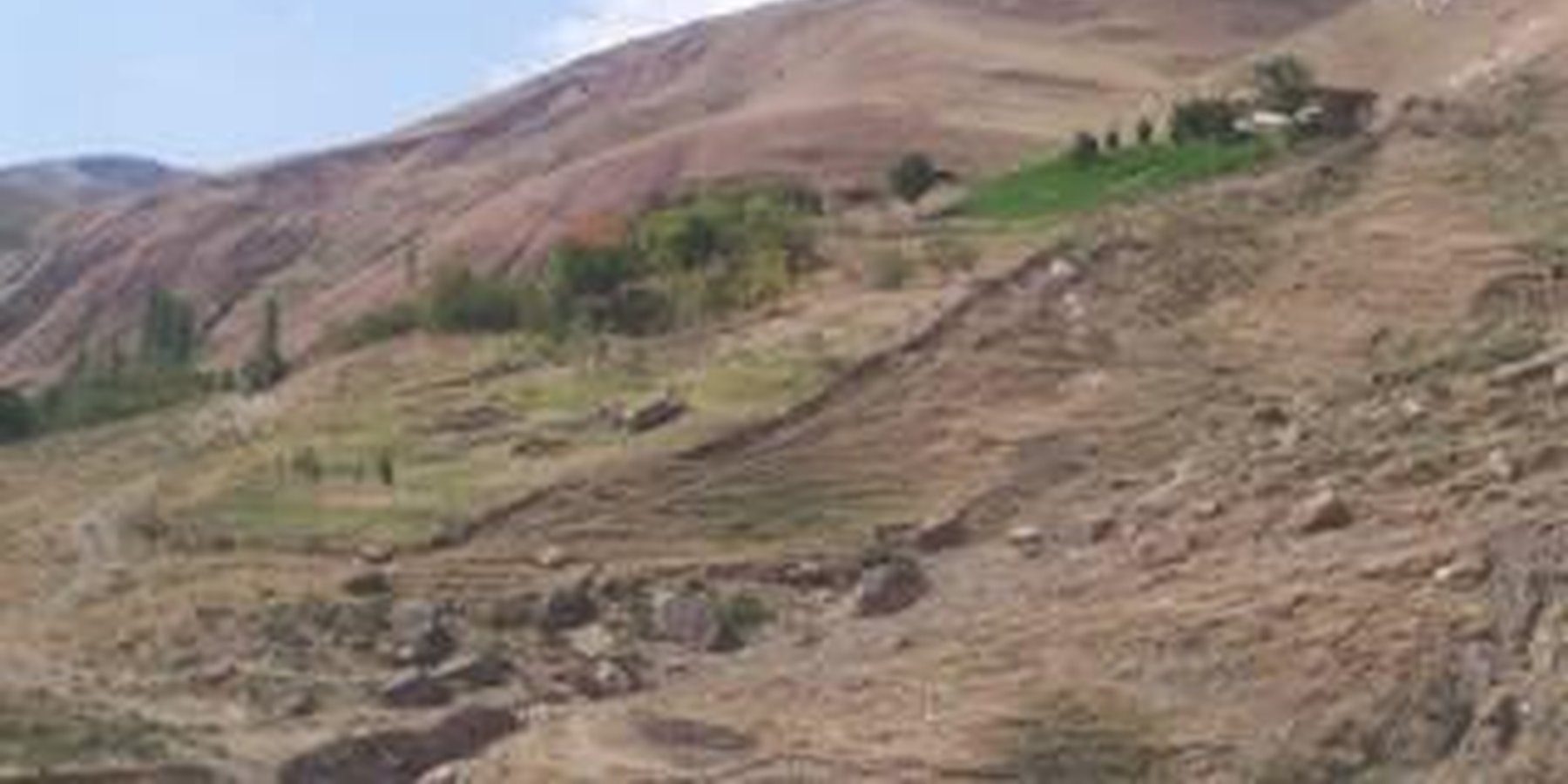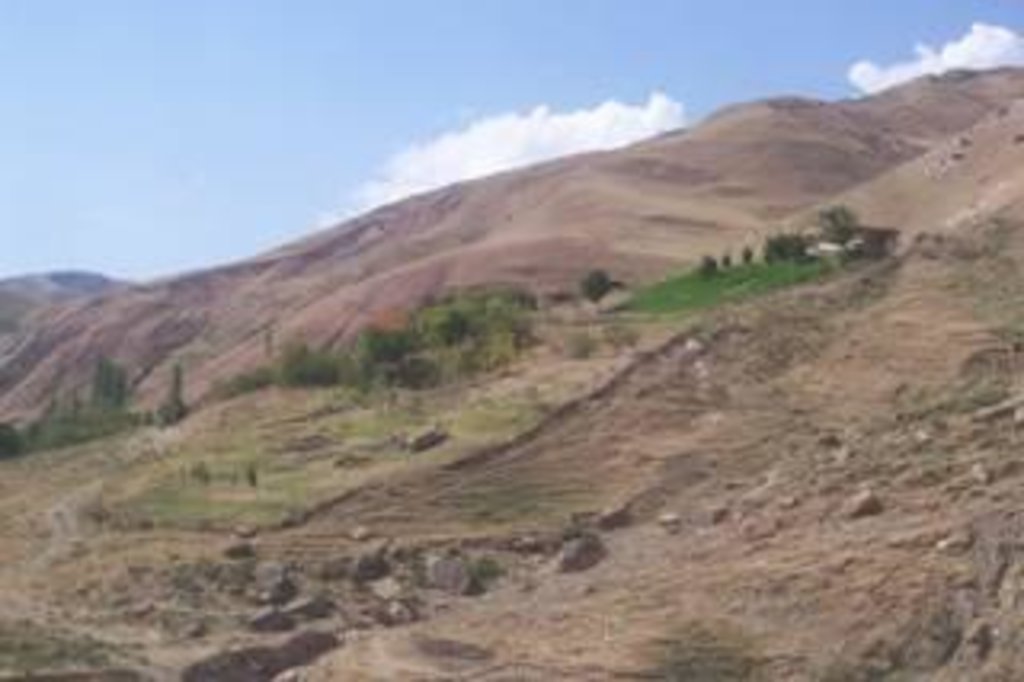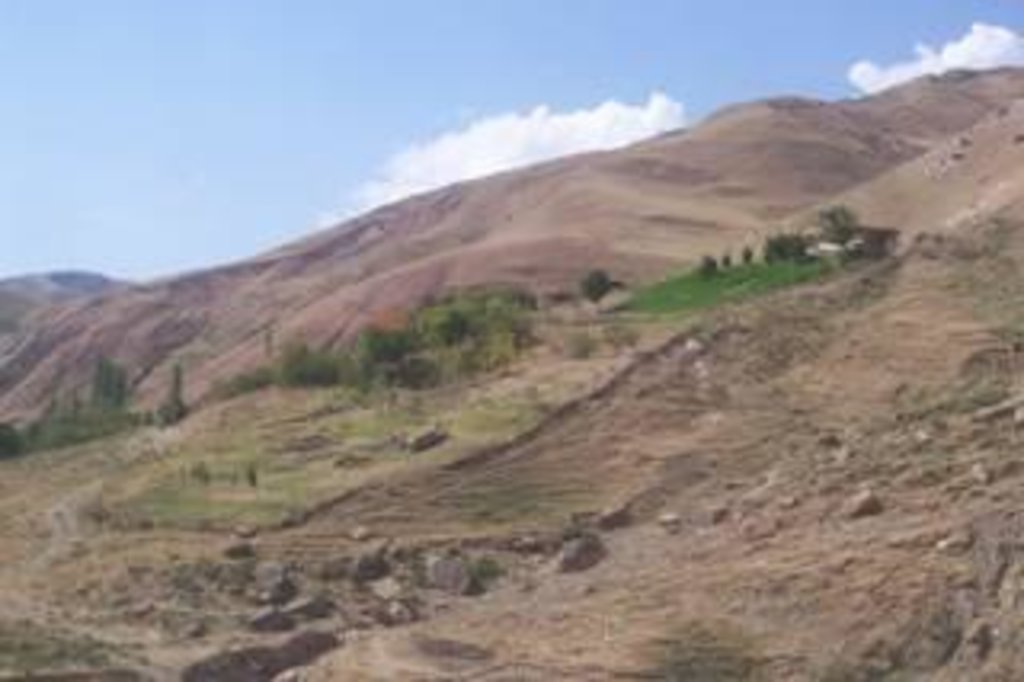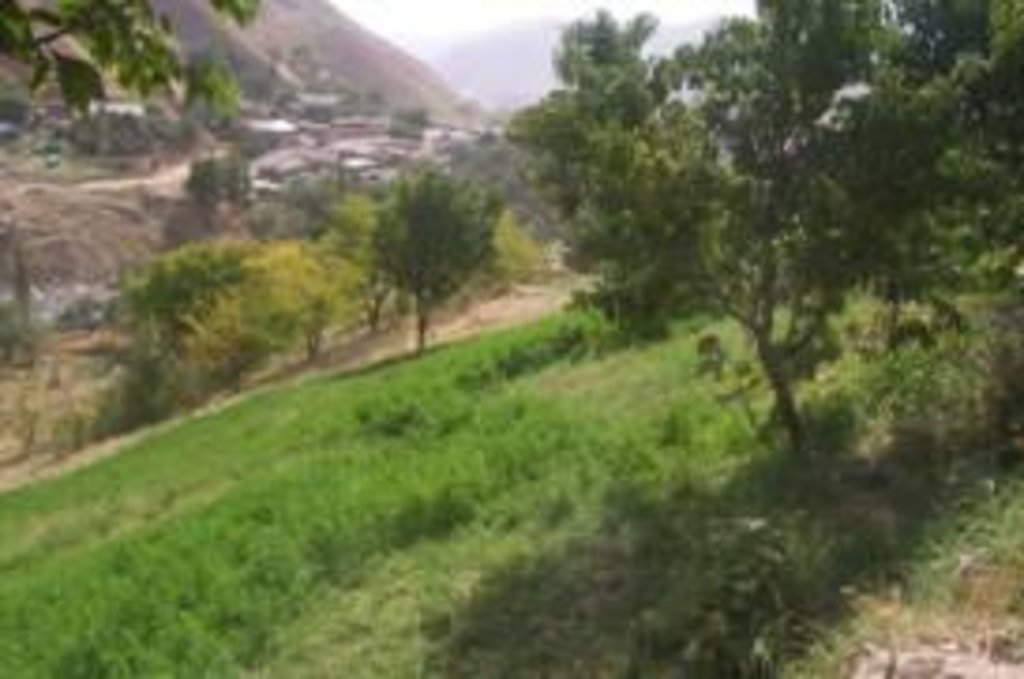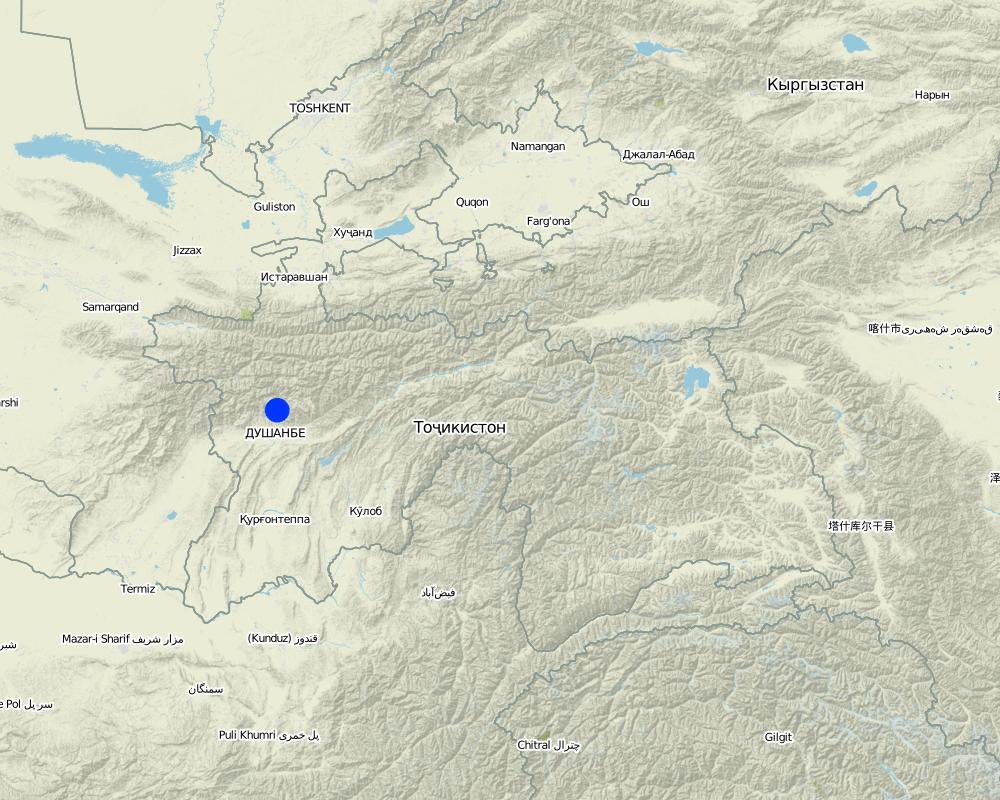Enhancement of existing SLM technologies into demonstration sites [ប្រទេសតាហ្ស៊ីគីស្ថាន]
- ការបង្កើត៖
- បច្ចុប្បន្នភាព
- អ្នកចងក្រង៖ Habib Kamolidinov
- អ្នកកែសម្រួល៖ –
- អ្នកត្រួតពិនិត្យ David Streiff
ADB, GEF, GITEC, DMC. Rural Development Project
approaches_2634 - ប្រទេសតាហ្ស៊ីគីស្ថាន
- សង្ខេបជា PDF
- សេចក្តីសង្ខេបពេញលេញជាទម្រង់ PDF សម្រាប់បោះពុម្ព
- សេចក្តីសង្ខេបពេញលេញទម្រង់អ៊ីនធឺនេត
- សេចក្តីសង្ខេបពេញលេញ (មិនមានទម្រង់ជាក់លាក់)
- Enhancement of existing SLM technologies into demonstration sites : 6 ខែ កក្កដា ឆ្នាំ 2017 (inactive)
- Enhancement of existing SLM technologies into demonstration sites : 9 ខែ សីហា ឆ្នាំ 2017 (inactive)
- Enhancement of existing SLM technologies into demonstration sites: 2 ខែ វិច្ឆិកា ឆ្នាំ 2021 (public)
ពិនិត្យមើលគ្រប់ផ្នែក
ពង្រីកមើលទាំងអស់ បង្រួមទាំងអស់1. ព័ត៌មានទូទៅ
1.2 ព័ត៌មានលម្អិតពីបុគ្គលសំខាន់ៗ និងស្ថាប័នដែលចូលរួមក្នុងការវាយតម្លៃ និងចងក្រងឯកសារនៃវិធីសាស្ត្រផ្សព្វផ្សាយ
អ្នកជំនាញឯកទេស SLM:
ឈ្មោះអង្គភាពមួយ (ច្រើន) ដែលបានចងក្រងឯកសារ/ វាយតម្លៃលើវិធីសាស្ត្រផ្សព្វផ្សាយ (បើទាក់ទង)
GITEC/ADB/DMC Rural Development Project Land Management Institute - ប្រទេសតាហ្ស៊ីគីស្ថាន1.3 លក្ខខណ្ឌទាក់ទងទៅនឹងការប្រើប្រាស់ទិន្នន័យដែលបានចងក្រងតាមរយៈវ៉ូខេត
អ្នកចងក្រង និង(បុគ្គលសំខាន់ៗ)យល់ព្រមទទួលយកនូវលក្ខខណ្ឌនានាទាក់ទងទៅនឹងការប្រើប្រាស់ទិន្នន័យដែលបានចងក្រងតាមរយៈ វ៉ូខេត:
បាទ/ចា៎
2. ការពណ៌នាអំពីវិធីសាស្ត្រផ្សព្វផ្សាយ SLM
2.1 ពណ៌នាសង្ខេបខ្លីពីវិធីសាស្ត្រផ្សព្វផ្សាយ
Enhancement of existing self developed SLM technologies into demonstration sites.
2.2 ពណ៌នាលម្អិតពិវិធីសាស្ត្រផ្សព្វផ្សាយ
ពណ៌នាលម្អិតពិវិធីសាស្ត្រផ្សព្វផ្សាយ:
Aims / objectives: The farmer clearly stated that his prime, initial aim in taking over this “ruined and abandoned land” was to improve and better assure the quality of his family’s lifestyle, through enhanced and assured food and fodder production. He also recognised the potential for future profit, through sale of his excess produce to market. Currently, the family has almost no need to buy food (and fodder) from nearby markets, apart from flour (for bread making). This is a large cost saving factor. In hindsight, the farmer sees that he has dramatically improved land quality within the enclosure through mitigating erosion and increasing year-round vegetation cover
Methods: The success of the enclosure is the result of using several methods. The fence construction was critical to keep out both domestic animals (cattle, goats and sheep) and wild ones, (pigs and wolves) from what was to become a vegetation rich “island” amoungst the bare and degraded hillslopes. Stone clearing (by hand) of the whole area inside the enclosure greatly improved land quality due to enhanced soil depth and subsequent vegetative growth. Tree planting (apple, cherry, apricot, pear) was critical to provide family food. Lucerne planting provided food for the farmer’s animals (1 cow, 10 goats) that provide milk and meat. A small area of land near the homestead (approx. 20 x 20 metres) was levelled into several small terraces for vegetable production (potatoes, garlic, onion, peppers, tomatoes). Irrigation is conducted within the upper part of the enclosure; water being provided by a 20mm polythene pipe that brings water from 1.5 km away where there is a permanent spring.
Stages of implementation: The family (Enomali) first occupied this land in 1984. The first task was tree planting – the first orchard trees – on 0.1 ha of the current enclosure. This was fenced, then after nine family members left (to work in Dushanbe) he expanded the fence to the current 0.2 ha and continued to plant trees. Stone removal continued through the 1990s and even to today. The lucerne and vegetable gardens were initiated in the 1990s and continue to be enriched. The fodder, trees and vegetable production is an ongoing task, as is feeding the animals with the home-grown fodder. He continues to plant orchard trees every year and currently has more than 100. He gained a “certificate” of ownership” in 2008.
Role of stakeholders: All of the work within the enclosure has been conducted by family members. The main two are the husband and wife, though in the early stone clearing and fence construction days his 1st cousin assisted. His son and daughter in law have also assisted (though the son now works in Dushanbe) – even the young grandchildren help.
2.3 រូបភាពនៃវិធីសាស្ត្រផ្សព្វផ្សាយ
2.5 ប្រទេស/តំបន់/ទីតាំងកន្លែង ដែលវិធីសាស្ត្រផ្សព្វផ្សាយត្រូវបានអនុវត្តន៍
ប្រទេស:
ប្រទេសតាហ្ស៊ីគីស្ថាន
តំបន់/រដ្ឋ/ខេត្ត:
RRP
បញ្ជាក់បន្ថែមពីលក្ខណៈនៃទីតាំង:
Varzob, Luchob
Map
×2.6 កាលបរិច្ឆេទនៃការចាប់ផ្តើម និងបញ្ចប់នៃវិធីសាស្រ្តផ្សព្វផ្សាយនេះ
សូមបញ្ជាក់ឆ្នាំដែលបានបង្កើតឡើង:
1984
ឆ្នាំបញ្ចប់ (ប្រសិនបើវិធីសាស្ត្រផ្សព្វផ្សាយត្រូវបានឈប់ប្រើប្រាស់):
2014
មតិយោបល់:
The small area was all that the family could manage, as there was an initial large workload, clearing stones and fence building, etc
2.7 ប្រភេទនៃវិធីសាស្ត្រផ្សព្វផ្សាយ
- Local initiative enhanced by programme activity
2.8 គោលបំណង/ទិសដៅសំខាន់នៃវិធីសាស្ត្រផ្សព្វផ្សាយ
The Approach focused on SLM only
The prime, initial aim in taking over this “ruined and abandoned land” was to improve and better assure the quality of his family’s lifestyle through enhanced and assured food and fodder production. He also recognised the potential for future profit, through sale of his excess produce to market. Now, he wants to expand the area within the enclosure to 1 ha with extra fencing and supplementary irrigation supply from another spring.
The SLM Approach addressed the following problems: The main problem to be addressed was reducing poverty, to help achieve a better and more sustainable lifestyle by producing better quality food and fodder.
2.9 លក្ខខណ្ឌអនុញ្ញាត ឬរារាំងការអនុវត្តន៍បច្ចេកទេសដែលស្ថិតនៅក្រោមវិធីសាស្រ្តផ្សព្វផ្សាយ
សង្គម/វប្បធម៌/ និងតម្លៃនៃសាសនា
- រារាំង
This family were one of the first in this region to take over this area of “ruined” land and begin improvements. However, the farmer did not see this as arduous, rather he welcomed the chance to work hard and provide for his family
Treatment through the SLM Approach: Family working together to improve land
ភាពអាចរកបាននៃធនធានហិរញ្ញវត្ថុ និងសេវាកម្ម
- រារាំង
The farmer could improve his SLM but would need financial assistance
Treatment through the SLM Approach:
បរិបទនៃស្ថាប័ន
- រារាំង
He has now gained a certificate of ownership that ensures ownership until his death. The government still owns the land and he pays $5 US a year in tax (total).
Treatment through the SLM Approach: Application for land entitlement certificate
ក្របខណ្ឌច្បាប់ (សិទ្ធិកាន់កាប់ដីធ្លី កម្មសិទ្ធីប្រើប្រាស់ដីនិងទឹក)
- អំណោយផល
The existing land ownership, land use rights / water rights helped a little the approach implementation: There was no compelling need for the farmer to get a “entitlement certificate” but he did so anyway.
- រារាំង
Not applicable. The water (irrigation) is “free” and there are no current disputes over his use of the spring water
Treatment through the SLM Approach:
ចំណេះដឹងស្តីពី SLM និងការទទួលបានការគាំទ្រផ្នែកបច្ចេកទេស
- រារាំង
The family provided their own solutions to any problems since the project began in 1984
Treatment through the SLM Approach:
ទំហំការងារ ភាពអាចរកបាននៃកម្លាំងពលកម្ម
- រារាំង
The family have worked consistently for 26 years, slowly but have created better land and vegetation conditions
Treatment through the SLM Approach:
3. ការចូលរួម និងតួនាទីរបស់ភាគីពាក់ព័ន្ធ
3.1 អ្នកពាក់ព័ន្ធដែលបានចូលរួមក្នុងវិធីសាស្ត្រផ្សព្វផ្សាយ និងតួនាទីរបស់ពួកគេ
- អ្នកប្រើប្រាស់ដីក្នុងតំបន់/សហគមន៍
Only the land users (family)
The men focused on the heavier labour tasks of fence building and stone removal. The women focus on the garden, and fruit production and bee keeping.
3.2 ការចូលរួមរបស់អ្នកប្រើប្រាស់ដីក្នុងតំបន់/ សហគមន៍ក្នុងតំបន់ក្នុងដំណាក់កាលផ្សេងគ្នានៃវិធីសាស្រ្តផ្សព្វផ្សាយ
| ការចូលរួមរបស់អ្នកប្រើប្រាស់ដីក្នុងតំបន់/សហគមន៍ក្នុងតំបន់ | សូមបញ្ជាក់នរណាត្រូវបានចូលរួម ព្រមទាំងពណ៌នាសកម្មភាពទាំងនោះ | |
|---|---|---|
| ការចាប់ផ្តើម/ការលើកទឹកចិត្ត | គំនិតផ្តួចផ្តើមដោយខ្ឡួនឯង | The extended family, when available |
| ការរៀបចំផែនការ | គំនិតផ្តួចផ្តើមដោយខ្ឡួនឯង | Principally the husband and wife – Mr Enomali and wife |
| ការអនុវត្តន៍ | គំនិតផ្តួចផ្តើមដោយខ្ឡួនឯង | The family |
| ការត្រួតពិនិត្យ និងវាយតម្លៃ | គំនិតផ្តួចផ្តើមដោយខ្ឡួនឯង | Mr Enomali and his wife are continuously evaluating the production quantities and quality from their labours |
| Research | គ្មាន | Not applicable |
3.4 ការសម្រេចចិត្តលើការជ្រើសរើសបច្ចេកទេស SLM
សូមបញ្ជាក់តើអ្នកណាជាអ្នកបានសម្រេចចិត្តក្នុងការជ្រើសរើសបច្ចេកទេសដើម្បីយកមកអនុវត្តន៍:
- អ្នកប្រើប្រាស់ដីដោយខ្លួនឯងផ្ទាល់ (គំនិតផ្តួចផ្តើមដោយខ្លួនឯង)
ចូរពន្យល់:
The family has chosen and implemented all methods within the enclosure with no external assistance of any type.
Decisions on the method of implementing the SLM Technology were made by by land users* alone (self-initiative / bottom-up). The family has chosen and implemented all methods within the enclosure with no external assistance of any type.
4. ជំនួយបច្ចេកទេស ការកសាងសមត្ថភាព និងការគ្រប់គ្រងចំណេះដឹង
4.1 ការកសាងសមត្ថភាព/ បណ្តុះបណ្តាល
តើវគ្គបណ្តុះបណ្តាលបានផ្តល់ឱ្យអ្នកប្រើប្រាស់ដី/អ្នកពាក់ព័ន្ធផ្សេងៗទៀតដែរឬទេ?
ទេ
4.2 សេវាផ្តល់ប្រឹក្សាយោបល់
តើអ្នកប្រើប្រាស់ដីបានទទួលនូវសេវាផ្តល់ប្រឹក្សាដែរ ឬទេ?
ទេ
4.3 ការពង្រឹងសមត្ថភាពស្ថាប័ន (ការអភិរឌ្ឍន៍អង្គភាព)
តើស្ថាប័នទាំងអស់ត្រូវបានបង្កើតឡើង ឬពង្រឹងសមត្ថភាពតាមរយៈវិធីសាស្ត្រផ្សព្វផ្សាយដែរ ឬទេ?
- ទេ
4.4 ការត្រួតពិនិត្យ និងវាយតម្លៃ
តើការត្រួតពិនិត្យ និងវាយតម្លៃគឺជាផ្នែកមួយនៃវិធីសាស្ត្រដែរឬទេ?
បាទ/ចា៎
មតិយោបល់:
bio-physical aspects were ad hoc monitored by land users through observations; indicators: The family, generally, take note of the effect of their practices in terms of production
economic / production aspects were None monitored by None through observations; indicators: None
There were no changes in the Approach as a result of monitoring and evaluation: None
There were no changes in the Technology as a result of monitoring and evaluation: None
4.5 ការស្រាវជ្រាវ
តើការស្រាវជ្រាវ គឺជាផ្នែកមួយនៃវិធីសាស្រ្តដែរឬទេ?
ទេ
5. ថវិកា និងសម្ភារៈឧបត្ថម្ភពីខាងក្រៅ
5.1 ថវិកាប្រចាំឆ្នាំសម្រាប់ផ្សព្វផ្សាយ SLM
ប្រសិនបើចំនួនពិតប្រាកដនៃថវិកាប្រចាំឆ្នាំមិនត្រូវបានដឹងច្បាស់ សូមប្រាប់ពីចន្លោះនៃថវិកានោះ:
- < 2,000
មតិយោបល់ (ឧ. ប្រភពសំខាន់នៃមូលនិធិ/ម្ចាស់ជំនួយចំបង):
Approach costs were met by the following donors: local community / land user(s) (The Emomali family): 100.0%
5.2 ការគាំទ្រផ្នែកហិរញ្ញវត្ថុ / សម្ភារៈដែលបានផ្តល់ទៅឱ្យអ្នកប្រើប្រាស់ដី
តើអ្នកប្រើប្រាស់ដីបានទទួលការគាំទ្រផ្នែកហិរញ្ញវត្ថ/សម្ភារៈសម្រាប់ការអនុវត្តន៍បច្ចេកទេសដែរឬទេ:
ទេ
5.3 សូមបញ្ជាក់ពីធាតុចូលត្រូវបានផ្តល់បដិភាគ (រួមទាំងកម្លាំងពលកម្ម)
ប្រសិនបើកម្លាំងពលកម្មធ្វើដោយអ្នកប្រើប្រាស់ដី តើវាជាធាតុចូលដ៏សំខាន់មួយដែរ ឬទេ:
- ដោយស្ម័គ្រចិត្ត
មតិយោបល់:
all labour was family-provided
5.4 ឥណទាន
តើឥណទានដែលបានផ្តល់នៅក្រោមវិធីសាស្ត្រផ្សព្វផ្សាយសម្រាប់សកម្មភាព SLM នេះយ៉ាងដូចម្តេច?
ទេ
6. ការវិភាគរកផលប៉ះពាល់ និងសេចក្តីសន្និដ្ឋាន
6.1 ផលប៉ះពាល់នៃវិធីសាស្ត្រផ្សព្វផ្សាយ
តើវិធីសាស្ត្រផ្សព្វផ្សាយជួយអ្នកប្រើប្រាស់ដីដើម្បីអនុវត្តន៍ និងថែទាំបច្ចេកទេស SLM?
- ទេ
- បាទ/ច៎ា បន្តិចបន្តួច
- បាទ/ច៎ា ជាមធ្យម
- បាទ/ច៎ា បានខ្លាំង
There is a dramatic visible difference in both the degree of erosion and vegetative land cover between the enclosure and the surrounding land (see picture in 1.3.3). Also, the production quantity and quality of food and fodder from this enclosure has continued to increase.
តើវិធីសាស្ត្រផ្សព្វផ្សាយនេះផ្តល់សិទ្ធិអំណាចដល់សង្គមនិងសេដ្ឋកិច្ចដែលក្រុមមិនទទួលបានផលប្រយោជន៍?
- ទេ
- បាទ/ច៎ា បន្តិចបន្តួច
- បាទ/ច៎ា ជាមធ្យម
- បាទ/ច៎ា បានខ្លាំង
After the fall of the Soviet Union, many in Tajikistan experienced poverty, particularly food shortages. This farmer foresaw this and commenced his enclosure enrichment work. In this way he ensured
Did other land users / projects adopt the Approach?
- ទេ
- បាទ/ច៎ា បន្តិចបន្តួច
- បាទ/ច៎ា ជាមធ្យម
- បាទ/ច៎ា បានខ្លាំង
The farmer says that several of his neighbours have been doing similar interventions to his – fencing, stone removal, planting orchards etc. What he has done is very visible from the main road through the valley, and many people have observed the results of his efforts over the years
Did the Approach lead to improved livelihoods / human well-being?
- ទេ
- បាទ/ច៎ា បន្តិចបន្តួច
- បាទ/ច៎ា ជាមធ្យម
- បាទ/ច៎ា បានខ្លាំង
His family eat well, plentiful and very fresh/organic produce from their own household plot
Did the Approach help to alleviate poverty?
- ទេ
- បាទ/ច៎ា បន្តិចបន្តួច
- បាទ/ច៎ា ជាមធ្យម
- បាទ/ច៎ា បានខ្លាំង
6.2 ការលើកទឹកចិត្តចម្បងៗរបស់អ្នកប្រើប្រាស់ដីសម្រាប់ការអនុវត្តបច្ចេកទេស SLM
- បង្កើនផលិតកម្ម
- ពង្រឹងស្មារតីផ្នែកបរិស្ថាន
- well-being and livelihoods improvement
6.3 សកម្មភាពផ្សព្វផ្សាយដែលប្រកបដោយចីរភាព
តើអ្នកប្រើប្រាស់ដីអាចធ្វើឱ្យមានចីរភាពនូវអ្វីដែលត្រូវបានអនុវត្តន៍តាមរយៈវិធីសាស្ត្រផ្សព្វផ្សាយដែរឬទេ(ដោយពុំមានការគាំទ្រពីអ្នកខាងក្រៅ)?
- បាទ/ចា៎
ប្រសិនបាទ/ច៎ា សូមរៀបរាប់ថាធ្វើយ៉ាងម៉េច:
The farmer never had external “support” in the first place, so his approach continues to improve, with no support.
6.4 ភាពខ្លាំង/ គុណសម្បត្តិនៃវិធីសាស្ត្រផ្សព្វផ្សាយ
| ភាពខ្លាំង/ គុណសម្បត្តិ/ ឱកាស ទស្សនៈរបស់អ្នកប្រើប្រាស់ដី |
|---|
| As above, as these words were transcribed during the farmer interview, on site |
| ភាពខ្លាំង/ គុណសម្បត្តិ/ ឱកាស ទស្សនៈរបស់បុគ្គលសំខាន់ៗ |
|---|
| Though not an initial objective, the farmer now recognises that he has dramatically improved land quality and vegetation cover within the enclosure, further assuring continued increased production through improved soil conditions (How to sustain/ enhance this strength: By continuing to do what he has been doing for 20+ years already. ) |
| The farmer has achieved what he wanted; assured quantity and quality of food/fodder production to assure his family’s livelihood. (How to sustain/ enhance this strength: He wants to increase his enclosure area by 5 times. To do this he will require fencing and pipe for irrigation.) |
6.5 ភាពខ្សោយ/ គុណវិបត្តិនៃវិធីសាស្ត្រ និងរកដំណោះស្រាយ
| ភាពខ្សោយ/ គុណវិបត្តិ/ ហានិភ័យ ទស្សនៈរបស់អ្នកប្រើប្រាស់ដី | តើបច្ចេកទេសទាំងនោះបានដោះស្រាយបញ្ហាដូចម្តេច? |
|---|---|
| As above, as these were the sentiments of the farmer during on site interview |
| ភាពខ្សោយ/ គុណវិបត្តិ/ ហានិភ័យក្នុងទស្សនៈរបស់បុគ្គលសំខាន់ៗ | តើបច្ចេកទេសទាំងនោះបានដោះស្រាយបញ្ហាដូចម្តេច? |
|---|---|
| The farmer does not have sufficient financial means to purchase the additional fencing and irrigation pipe he requires to extend the current enclosure area to 1 ha size | Involvement of local banks |
| The total lack of institutional support. This has not necessarily negatively impacted on the farmer – but rather has led to a reduced uptake of his (excellent) practices elsewhere, both locally and nationally. | Immediate visits of local agronomic staff (governmental) to record the modalities of what has been achieved at this site, to help ensure the wider implementation for improved land quality and vegetative cover, at a more national level. |
7. ឯកសារយោង និងវេបសាយ
7.1 វិធីសាស្ត្រ/ ប្រភពនៃព័ត៌មាន
- តាមការចុះទីវាល ការស្រាវជ្រាវនៅទីវាល
- ការសម្ភាសន៍ជាមួយអ្នកប្រើប្រាស់ដី
7.2 ឯកសារយោងដែលបានចេញផ្សាយ
ចំណងជើង អ្នកនិពន្ធ ឆ្នាំ ISBN:
There is no relevant documentation
ការតភ្ជាប់ និងម៉ូឌុល
ពង្រីកមើលទាំងអស់ បង្រួមទាំងអស់ការតភ្ជាប់
គ្មានការតភ្ជាប់
ម៉ូឌុល
គ្មានម៉ូឌុល


